You might have seen people in the gym training with an altitude training mask. These strange masks, like the one pictured below, sit around the mouth and the nose. Many people think that these can improve your performance by changing your breathing, recreating the effect of training at altitude while in the gym.
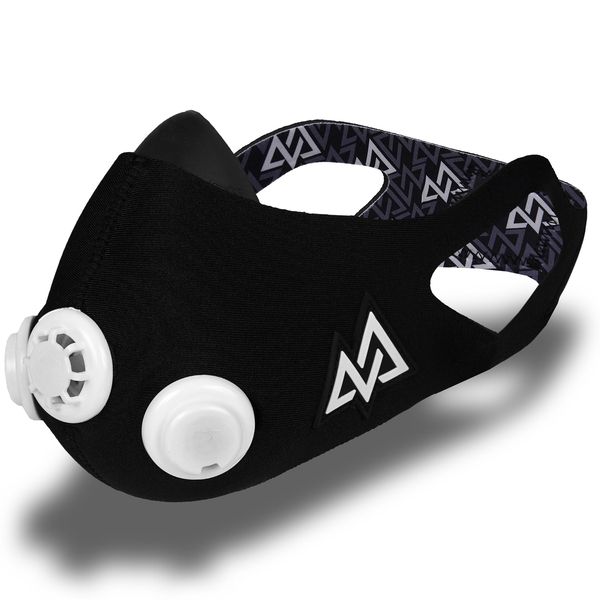
The Elevation Training Mask 2.0. Source: https://www.trainingmask.com/
While I’m not aware of any professional sporting organisations that endorse them, plenty of individual athletes do.
But how well do they work? In this article we review the evidence supporting claims made about these masks. Do they stand up to scrutiny? Read on to find out.
How do altitude training masks work?
If you go to the website of one of the major producers of these masks they currently don’t make claims about altitude. Instead, they state that their masks are designed to ‘apply variable levels of load to respiratory muscles by controlling air flow pass through; this increases tension on your breathing – which makes you more powerful and efficient over a long workout.’
There have been several versions of the mask from this company, but as most of the research has examined their model 2.0, that’s the one we’ll discuss today.
From what I can work out though, the different brands and all models are all used roughly the same way. The mask fits snuggly over the nose and mouth. Some holes in the mask can be opened, or covered, with plastic caps. In the Training Mask 2.0, the combination used represents different altitudes. Fewer holes open makes it harder to breath (i.e. higher altitude), while more makes it easier.
Your expired air is captured in the mask, and will diffuse with air from outside the mask more slowly. So you are rebreathing air with a lower proportion of oxygen, and more carbon dioxide.
Do these masks simulate high altitude?
Altitude training has been used for a long time to lead to better performance in endurance events. However, experts disagree about if there’s much benefit, but here’s how it is thought to work:
At altitude, we get less oxygen with each breath, which restricts our ability to exercise. Red blood cell production increases, so that the oxygen carrying capacity of our blood improves. When you then exercise at sea level, this extra carrying capacity leads to a performance improvement.
The masks work differently.
They restrict the flow of fresh air, so you end up working harder to draw the same breath, like trying to breathe through a straw. You may also rebreathe some of your expired air, as mentioned above.
This is not the same as altitude, when the air is thinner, and both oxygen and carbon dioxide levels are reduced.
So we can’t assume the mask has the same effect as altitude. We need to test this. Luckily, there’s plenty of research we can look at to find out…
How well do altitude training masks work?
Now things get interesting! Unlike other fitness products, this one does use some research to support their claims. The website we looked at earlier cites one piece of research supporting how these masks work to improve fitness. The research was led by Professor John Porcari, who regularly assesses the claims of fitness products.
Porcari identified claims that the masks improved lung function, and VO2max, which is the maximum amount of oxygen we can take in when exercising. VO2max is a major limiting factor in our ability to exercise aerobically.
To test this, a group wearing a mask, and a group without the mask, did high-intensity bike training for six weeks (two sessions a week).
Both groups improved in VO2max. But there was no difference between them, so the mask didn’t make any difference here.
Ventilatory threshold improved in the mask group. This is the point while increasing our exercise intensity that we start relying on higher intensity energy systems. But most other measures didn’t change, and participants in the mask condition thought the exercise was harder.
So results were mixed. The conclusions were that the mask may have an effect, but doesn’t simulate altitude effectively.
So what is the effect of the mask?
Porcari and colleagues suggested that the mask may have an effect of training respiratory muscles, an idea which has some merit. But this didn’t lead to a performance benefit.
And this is the only piece of research they cite on this topic, which doesn’t fill me with confidence. This is an example of cherry picking, which means they are ignoring other evidence on the topic. So what does this other research say?
Cardio training effects of altitude masks
Other research has shown similar results*, though were less generous in their conclusions. Though there are a lot of variables researchers could look at, there are several key measures that show up regularly when testing these masks.
One is the saturation of oxygen in the blood. This is how much oxygen is transported, as a percentage of our blood’s capacity. This is usually 96-99% in the normal person at sea level. It decreases to about 80% at 4000m of altitude, though improves when you adapt to that altitude. If these masks simulate altitude, this should drop as the mask is worn.
Another is blood lactate, which is an indication of the contribution of anaerobic energy systems to exercise. At higher intensities, blood lactate builds up. At the same intensity, and in the presence of less oxygen, we could expect blood lactate levels to be higher.
Most importantly, aerobic fitness should increase over time. If the masks are effective, we should see an improvement in VO2max greater than when the same training is done without the mask. All the blood tests in the world aren’t as convincing as an actual performance benefit! Porcari’s research didn’t show this, instead pointing to change in some other scores which suggested it was plausible that it could happen.
A 2016 study found that oxygen saturation in blood was less when wearing a mask compared to a placebo mask (about 94% to 90%). But this only looked at individual bouts of exercise, not training over time. So they didn’t assess changed in fitness.
Other research compared the mask to hypoxic training in an altitude chamber, and a control group, for 6 weeks of interval training. They found oxygen saturation in the mask was no better than the control group, while the altitude chamber was. They concluded that the mask did not simulate altitude.
In fact, none of the research I could find has shown an increase in VO2max while using the mask that is greater than training without the mask (see also Biggs et al., 2017; Sellers, et al. 2015; Warren et al., 2017).
What about resistance training?
The training mask website presents one study showing that muscle hypertrophy was improved when using the masks, though strength wasn’t. This was quite a small study though, and the bulk of other research has shown there is no hypertrophy effect from training in hypoxia – and if you remember from earlier, it’s not clear that the masks even create this condition.
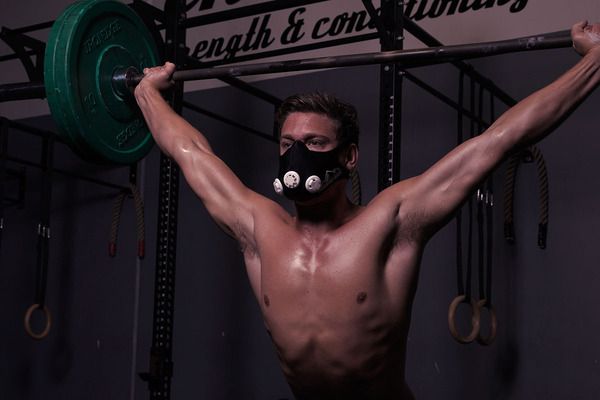
Unlike with cardio training, altitude training masks may actually make our exercise performance worse. “Training Mask Oceania” by Carly Reeves CC BY-NC-ND 4.0.
There are two other studies I’ve found that looked at resistance training using these masks, and their conclusions were the same: the masks don’t help our training performance.
One used both a mask and a control condition, and participants did 5 sets of squats and bench press until fatigue, with 60s rest between sets – a pretty hard work out! In the mask group participants failed earlier, recorded higher blood lactates, and perceived the exercise as harder.
So while the masks probably changed the energy system contributions during training (relying more on anaerobic metabolism), performance dropped. So we might benefit less from our resistance training. And more recent research has supported this.
A more recent, similar study found no difference in workload or blood lactate, but slower peak velocity of the bar during sets. So again, this may effect the adaptation we get from our exercise. And oxygen saturation was 97%, so the masks were probably not simulating altitude effectively anyway.
And as an additional issue, 3 (out of 26) participants reported discomfort, feeling light-headed, or experiencing anxiety while wearing the masks.
When we’re lifting weights, often we aren’t concerned about the energy system that is providing the fuel for our exercise. We are looking for a stimulus for our muscles and our nervous system. So making our training harder, and increasing anaerobic metabolism, may just reduce the effect of our training.
But if it feels harder, we often assume it is better for us. “No pain, no gain”, right?
So what’s the verdict on altitude training masks?

Altitude training mask – what’s the verdict
As usual, the reality is more complicated than the marketing claims. It’s not just a case of reducing oxygen availability to increase fitness. The masks are not simulating altitude well enough to do this.
The evidence so far just doesn’t provide clear support for the use of these masks to improve fitness. They may stress the breathing musculature, which in theory could improve lung capacity and deliver more oxygen to working muscles over time.
But exercise with the masks feels harder… therefore it must be working, right?! It’s a common idea today that when exercising, the harder the better! But this misses the point. We can train at the right intensity, for the right length of time, in the right way, to get the effect we want. More, or harder training, does not automatically mean more benefit.
The final word

Want to try altitude masks? Go for it. But the evidence to support them isn’t great so far. Image by freepik – www.freepik.com
To be generous, I’d say the verdict is mixed**. If you want to give it a try, go for it. If the mask has an effect, it’s a small one. We’re yet to see a clear benefit with cardio training, and the different mask settings don’t seem to make a difference.
And it seems that your resistance training suffers. You’re probably not able to provide the same stimulus to the muscle as you would without the mask. In the long run, that will hurt any size and strength benefit you are looking for.
*I excluded some research that only looked at single bouts of exercise, or when mask and control conditions were not matched for exercise intensity or duration. Both these issues limit what real world applications we can get from this research.
**if you want another opinion, try this summary. It’s about a year older than this one, and draws on slightly different research, but reaches a similar conclusion.
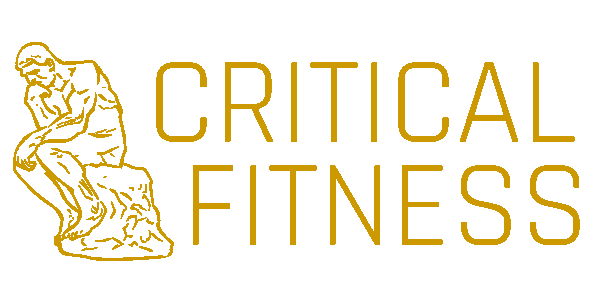
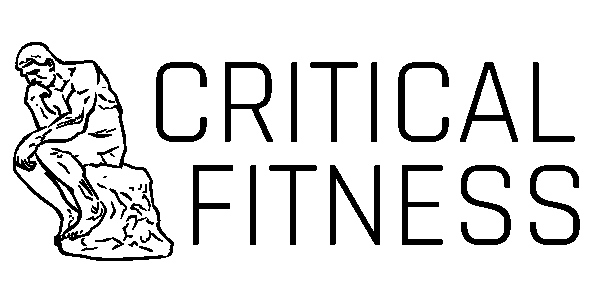
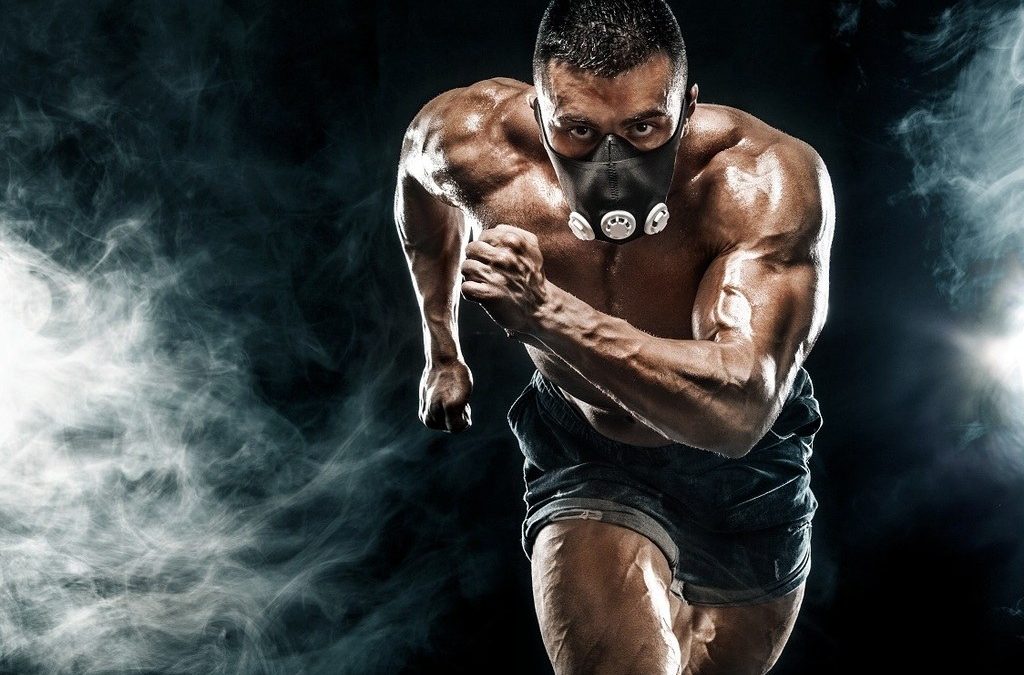
what if you used the mask to train your breathing , like you would train any other muscle, would there be any improvement or benefits.
Hi Juan, I think that’s why most people wear them. But it’s not clear to me that there’s much benefit, based on the evidence I’ve seen so far.
I have used one. It greatly improved my breathing while running due to the fact that the mask depletes you oxygen intake. I realized that I had been chest breathing, which can tire you out more quickly with the short breaths taken in and exhaled while running. So with less oxygen coming in, while wearing the mask, I started breathing deeper, from my diaphragm. By improving my breathing, I also improved my running. When I ran without the mask, I continued taking long deep breaths improving my endurance level which also increased my speed.
Ok. But, just talked to a friend in the elite military and they are using them in exercise training. Seems they may know something we don’t. I’ll go with them. It’s worth a try. The research quoted here did not show any signifant downside or risk.
Thanks for commenting Thomas. The masks certainly make our exercise feel harder. And we often assume that when something is harder we are getting more out of it – the military can fall prey to that misconception as much as anyone.
There is also some research (which I link to) showing that performance in resistance training is worse when wearing the mask. So there may be a downside in terms of resistance training benefit. But as you identify, there’s no risk, so anyone that wants to try them is always welcome to.
I was running with an N95 and noticed that my vo2 max as calculated by garmin watch had significantly improved! I was wearing the mask as there is smoke from wildfires in our neighborhood. The only thing that I had changed was wearing the mask. Now I understand that the vo2 max calculated by garmin is just an estimate based on heart, breathing rate and oxygen saturation, but the fact that the estimate was higher out of the blue while wearing a mask for a week or so was interesting.
Thanks for contributing Gouri, and hope the fires don’t get too close!
I don’t think the Garmin watches assess anything other than heart rate – gold standard lab based measurements measure the O2 and CO2 content of your expired air to calculate VO2max, but clearly the watch can’t do that. While I don’t have a simple explanation for what you observed, I did find out some more about the accuracy of these watches at the following link, which summarizes some research quite simply.
https://www.runnersworld.com/gear/a20856601/can-your-watch-estimate-your-vo2-max/#:~:text=VO2%20max%20is%20basically%20the%20definitive%20measurement%20of%20aerobic%20fitness.&text=This%20(along%20with%20basic%20information,your%20pace%20and%20heart%20rate.
I’m currently using a breathing restriction mask, and I believe that it does force me to learn how to breathe better while running.
If nothing else, at least it acclimates the body to workout with less oxygen, which comes in handy if when you’re training BJJ and someone is trying to choke you out and or sitting on top of you.
Thanks for reading Mike! The mask may change the conscious effort you put in to breathing, but it isn’t forcing you to work out with less oxygen, based on the consensus of evidence I’ve seen – if it did, we would see a significant, reliable chance in oxygen saturation in the blood. Unfortunately, this hasn’t been demonstrated.
There are some newer masks on the market, which I haven’t seen a lot of research on yet. Maybe one of these will be an improvement on earlier models, but like a good scientist I’ll withhold judgement until enough evidence is available.
you arent getting a leaner oxygen mixture but you are getting less oxygen volume… forcing your lungs to breath deeper and heart to work harder.. lifting with this mask also makes your mitochondria more efficient stamina wise.. its like breathing through a straw people.. you dont get hypoxia but you get other benefits.. i love these things
calling it an altitude mask is not accurate.. there is great benefit to using these… but its not the same as altitude training.
put one on and do 5 sets of deadlifts.. then do that for 6 weeks and tell me you didnt experience crazy stamina
Hi John, we’ve made some of the same points. And I agree, calling it an altitude mask is not accurate, for the reason you state in your comment… but it is marketed as one.
It’s great that you have a positive experience from these masks, however the research I’ve read doesn’t support any improvement in fitness levels.
According the author of “Breath” reducing the amount of oxygen and increasing the levels of CO2 in your system dose not decrease the level of oxygen in your blood. A very interesting book about breathing. Research about athletes using these techniques is in the book. A method where you have longer exhales than inhales.
I’m don’t quite understand the connection to the content of the article, could you explain?
Thank you for this. I was considering buying one as I’m training for fire academy which uses a scba and breathing is harder so I figured it’d support my training. I already practice slow breathing through qigong breathe work.
It seems that this may not benefit me much if anything no more than wearing a kn95 mask with another mask layer on top.
Thank you again.
My pleasure, glad I could help. Good luck with your training!
Here’s something you might find interesting!
Oddly enough, The only real improvement I’ve found from using these masks was a greater lung capacity/ better overall breathing technique during my rap performance shows (which my particular brand tends to leave very little room for breath, and tends to be very energetic) lol.
I used to get out of breath very quickly and would need to use the on-track adlibs or my hype-man to cover for the breath recovery. I didn’t focus on breathing technique as it relates to rap or anything of the sort during these last 6 weeks of training – just my martial arts training. Now I have no issue with breath control during shows.
Outside of that, I found no real improvement during my high-intensity kickboxing/ weight training – and actually found myself at a plateau rather than any kind of increase – strength or resistance-wise. I only found improvements in (possibly my total lung capacity, and) my ability to draw full lungs of air very quickly and efficiently without really having to think about it or purposely breath in that manner.
Laughably enough, rather than these masks being an effective way to improve your physical weight training, cardio, etc. I’ve found that these training masks are accidentally an effective tool for improving a high-intensity vocalist’s/ musician’s breath control.
I hadn’t thought of the effect on rapping, thanks for sharing!
Thanks!
So….. You didnt do a trial of training with the mask and without?!
Hi Jerome. No, I didn’t, because I know that sort of test isn’t worth a lot. Whatever my subjective impressions of training with or without these masks, I can’t tell what the longer term benefits will be. I just know what I feel in the moment of those workouts.
We tend to find these sorts of personal experiences convincing, but there’s lots of information we can’t get from these. This is why I look at what research has been done on products like these. Some of the research I cited (and linked to) identified that when exercising in these masks people definitely feel like they were training harder (their subjective RPE was higher). But they didn’t actually lift more, or get improvement in their fitness above and beyond what they would have done without the mask.
Thanks for the article. I have used similar mask in combat sports mainly mma. I found that the mask doesnt help you perform better in a short term, nor it makes you stronger, in fact the opposite. I got tired much sooner, caused visual blur under very heavy exercises due to lack of clean air. However, I continued to use it thinking it will help me at least improve my lung muscular performance, since in mma we tend to control opponent by placing heavy body weight on their abdomen and eventually making them tired or unable to fight/punch/kick hard. We call it “gas out the opponent”
So after about 2 months is when I really felt the benefits from the mask I used. In combat rounds I was performing far better than I have in past, I could withstand long term combative pressure even with very restrictive short breaths due to external abdominal pressure from opponent.
If you are planning to use it for strength, it will disappoint you, It will make you tired very soon, frustrate you and waste your money. If you are looking for endurance training, the mask will help that’s why its used in army. special forces and combat training. Additionally, it does NOT simulate low oxygen environment, it simply makes your body work harder with less oxygen and by rebreathing your own carbon dioxide over and over again. Your red blood cells count improves in a long term and your lung muscle performance increases. That’s why it will works for endurance training ONLY. This is just my experience and I am only expressing from my personal experience with “low altitude masks’
If anyone is seeking proper low altitude training, best is to attend a certified centre, where you run on a treadmill with a special mask under very low supply of air, heart monitor, and they make you do puzzles on a tablet to measure your physical and mental performance under low oxygen density. Look up H.A.C.E condition among mountain climbers.
Bit long, but hope it helps.
Thanks for taking the time to comment Nick. Sounds like you trained hard and got a lot fitter, nice work!
I’ve read several research articles that support the idea that there are performance benefits for aerobic exercise. It’s not monumental, and it lasts for about four weeks, but there is still research that supports a performance benefit. Granted it will not be as significant as training at high altitudes, it nevertheless does show performance benefits.
Hi Chris, if you can provide a reference or two, I would love to have a look. There’s a chance I’ve already referenced some of this research in my article, but I’d be happy to update it if there is new research I’m not aware of.